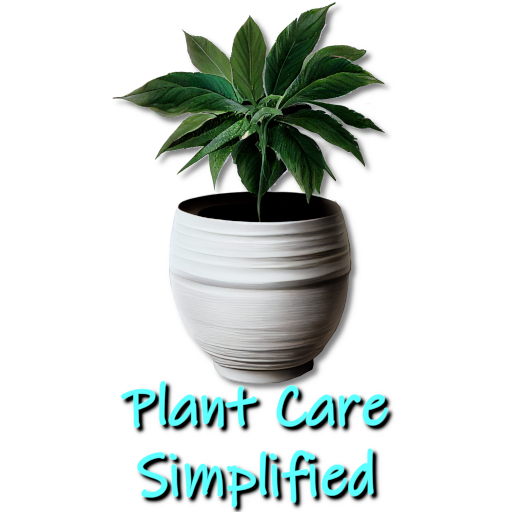Common Pests and Diseases Affecting Lipstick Plants
Kim is passionate about helping people create beautiful, healthy indoor spaces that are filled with plants. Kim believes that plants make us happier, healthier human...
- Lipstick plants, native to tropical regions of Asia and South America, can grow up to three feet long as trailing vines but can be vulnerable to pests and diseases.
- Common pests affecting lipstick plants include aphids, mealybugs, spider mites, and scale insects.
- Common diseases affecting lipstick plants are leaf spot, powdery mildew, root rot, and botrytis blight.
- Prevention and control measures for pests and diseases, such as regular inspection, manual removal, and use of natural predators or insecticides, are outlined for each.
- Preventative measures to minimize the chances of pests and diseases affecting lipstick plants are emphasized, including maintaining healthy soil, proper care and maintenance, correct spacing, and planting at the right time.
As with many plants, there are various common pests and diseases affecting lipstick plants that can impact their beauty and health. As beautiful, exotic houseplants that produce bright red, pink, or orange flowers resembling lipstick tubes, keeping them free from pests and disease plants will help maintain the plants for years to come.
The plants are native to tropical regions of Asia and South America and can grow up to three feet long as trailing vines. However, they can be attacked by various bugs and mites and are susceptible to several diseases that will affect their health and appearance. Below we will look at some of the most common pests and diseases affecting all varieties of lipstick plants and look at how best to prevent and treat them.
Key Takeaway
Lipstick plants, beautiful exotic houseplants known for their vibrant red, pink, or orange flowers, can be susceptible to various common pests and diseases. Preventative measures and treatment methods are discussed to maintain the health and appearance of these plants.
Common Pests Affecting Lipstick Plant
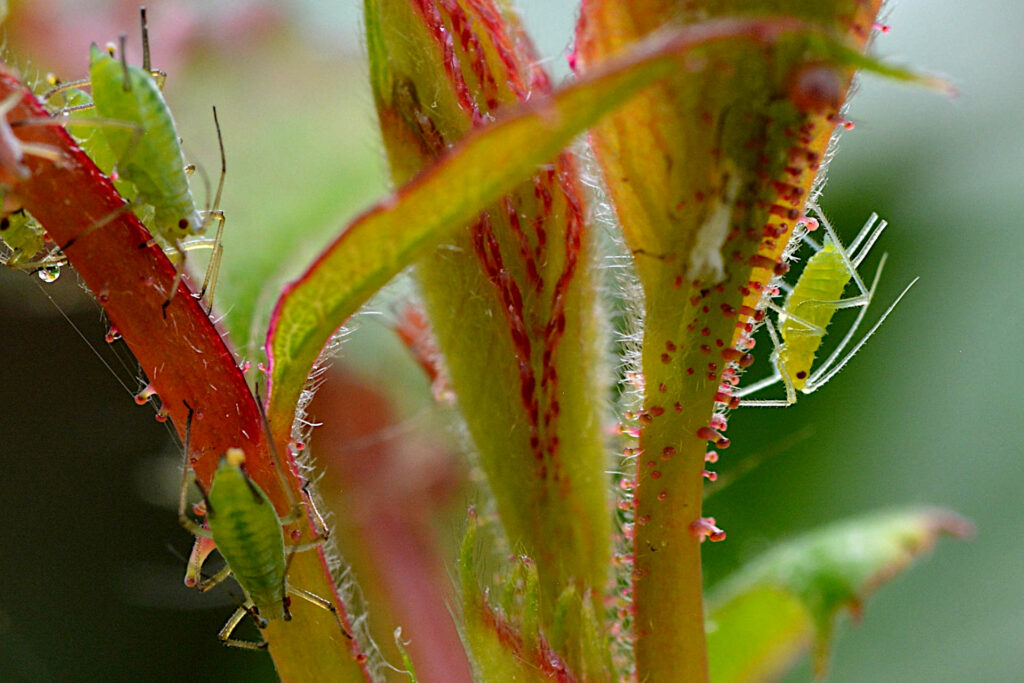
Below is a table summarizing information about the most common pests that affect lipstick plants and their prevention methods:
| Pest | Description and Identification | Signs of Infestation | Damage Caused | Prevention and Control Measures |
|---|---|---|---|---|
| Aphids | Small, soft-bodied insects with piercing-sucking mouthparts; cluster on undersides of leaves, stems, or flower buds | - Curling, yellowing, or wilting of leaves - Sticky honeydew on leaves or stems - Sooty mold - Deformed growth | Small, soft-bodied insects with piercing-sucking mouthparts; cluster on the undersides of leaves, stems, or flower buds | - Regular inspection and manual removal - Spraying with insecticidal soap, neem oil, or horticultural oil - Introducing beneficial insects |
| Mealybugs | Oval-shaped insects covered in white, waxy coating; hide in leaf axils, stem joints, or flower buds | - White, cottony masses on leaves, stems, or flowers - Sticky honeydew - Yellowing or dropping of leaves | - Weakening of plant's health - Transmission of viral diseases - Attraction of other pests - Reduced aesthetic value | - Regular inspection and manual removal - Spraying with insecticidal soap, neem oil, or horticultural oil - Isolating the infested plant |
| Spider Mites | Tiny arachnids with eight legs and two body segments; spin webs on undersides of leaves or stems | - Fine webs on leaves or stems - Tiny dots or specks on leaves - Yellowing, browning, or stippling of leaves | - Reduction in photosynthesis - Leaf loss and sunburn or dehydration<br>- Transmission of viral diseases | - Regular inspection and manual removal - Spraying with insecticidal soap, neem oil, or horticultural oil - Increasing humidity |
| Scale Insects | Oval-shaped insects covered with a hard, protective shell; attach to stems, leaves, or fruits | - Brown, gray, or white bumps on leaves, stems, or fruits - Sticky honeydew - Yellowing or dropping of leaves | - Weakening of plant's health - Transmission of viral diseases - Attraction of other pests - Reduced aesthetic value | - Regular inspection and manual removal - Spraying with insecticidal soap, neem oil, or horticultural oil - Pruning heavily infested parts |
Aphids
Aphids are small, soft-bodied insects that suck the sap from the plant's leaves and stems. They can be green, yellow, black, or brown in color and often cluster on the undersides of the leaves or on the flower buds. Aphids can cause the leaves to curl, wilt, or turn yellow and reduce the plant's vigor and flowering. They can also transmit viral diseases to the plant.
Signs of Aphid Infestation:
- Curling, yellowing, or wilting of leaves
- Sticky honeydew on leaves or stems
- Sooty mold
- Deformed growth
Inspect your lipstick plant regularly and remove any infested parts to prevent aphids. You can also spray the plant with water or insecticidal soap to dislodge and kill the aphids. Alternatively, you can introduce natural predators such as ladybugs or lacewings to control the aphid population.
Mealybugs
Mealybugs are white, cottony insects that feed on the plant's sap and secrete a sticky substance called honeydew. They can be found on the lipstick plant's stems, leaves, or roots. Mealybugs can cause the plant to become stunted, yellow, or drop its leaves and flowers. They can also attract ants and fungal growth on the honeydew.
Signs of Mealybug Infestation:
- White, cottony masses on leaves, stems, or flowers
- Sticky honeydew
- Yellowing or dropping of leaves
To prevent mealybugs, keep your lipstick plant healthy and avoid overwatering or overfertilizing it. You can also wipe off the mealybugs with a cotton swab dipped in alcohol or spray them with neem oil or horticultural oil. If the infestation is severe, you may need to use a systemic insecticide to kill the mealybugs.
Spider Mites
Spider mites are tiny, spider-like creatures that feed on the plant's cells and create fine webbing on the leaves and stems. They can be red, green, yellow, or brown in color and are usually invisible to the naked eye. Spider mites can cause the leaves to become speckled, dry, or fall off and reduce the plant's growth and flowering. They thrive in dry and hot conditions and can multiply rapidly.
Signs of Spider Mite Infestation:
- Fine webs on leaves or stems
- Tiny dots or specks on leaves
- Yellowing, browning, or stippling of leaves
To prevent spider mites, keep your lipstick plant moist and humid by misting it regularly or placing it on a tray of pebbles and water. You can also wash off the spider mites with water or use a miticide to kill them. Avoid using broad-spectrum insecticides as they can kill beneficial insects that keep spider mites in check.
Scale Insects
Scale insects are hard-shelled insects that attach themselves to the plant's stems and leaves and suck out its sap. They can be brown, gray, or black in color and look like bumps or scales on the plant. Scale insects can cause the plant to become weak, yellow, or drop its leaves and flowers. They can also secrete honeydew that attracts ants and fungal growth.
Signs of Scale Insect Infestation:
- Brown, gray, or white bumps on leaves, stems, or fruits
- Sticky honeydew
- Yellowing or dropping of leaves
To prevent scale insects, prune any infested branches and dispose of them properly. You can also scrape off the scale insects with your fingernail or a toothbrush or spray them with rubbing alcohol or horticultural oil. For heavy infestations, you may need to use a systemic insecticide to kill the scale insects.
Please be aware that the prevention methods listed are just general guidelines and will vary depending on the specific conditions of the pest problem.
Common Diseases Affecting Lipstick Plant
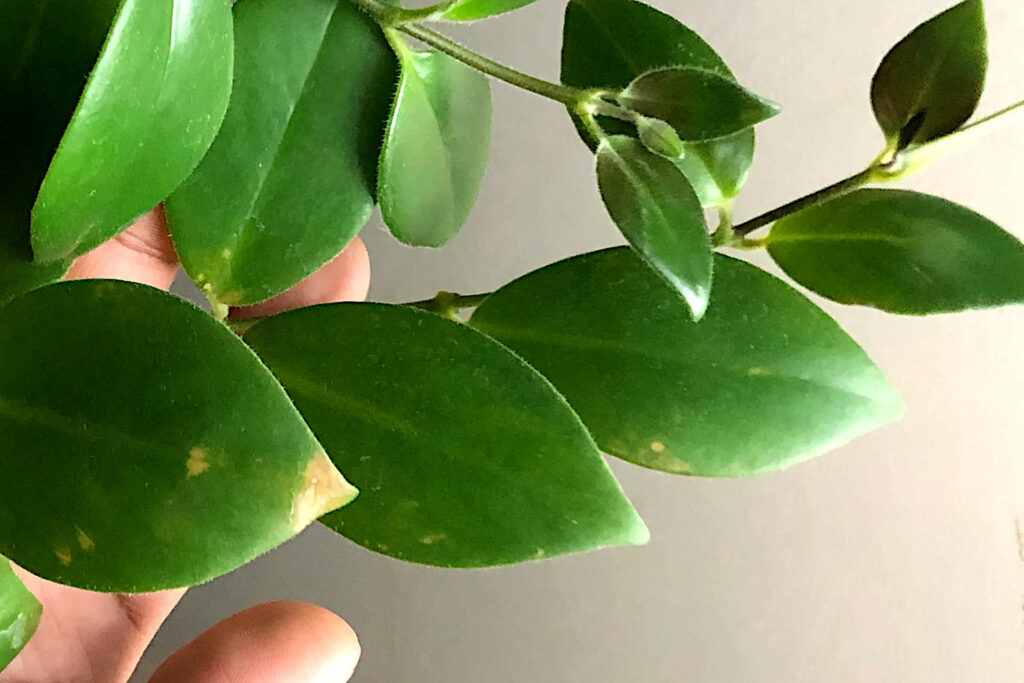
Here is a table summarizing the information about different diseases and their prevention methods for lipstick plants:
| Disease | Description | Symptoms | Prevention Methods |
|---|---|---|---|
| Leaf Spot | Fungal disease causing brown or black spots on leaves | - Brown or black spots on leaves - Yellowing and wilting of leaves - Premature leaf drop | - Avoid overhead watering and splashing water on leaves - Provide good air circulation - Remove and dispose of infected leaves - Use a fungicide spray if infection is severe |
| Powdery Mildew | Fungal disease with white, powdery coating | - White, powdery coating on leaves and stems - Distorted and discolored leaves - Reduced flowering and growth | - Reduce humidity - Increase light exposure - Prune the plant - Use a fungicide spray if infection is severe |
| Root Rot | Bacterial or fungal disease affecting roots | - Soft, brown, or black roots - Mushy or foul-smelling soil - Wilting, yellowing, or dropping of leaves - Stunted or no growth | - Use well-draining potting mix - Water when top soil is dry - Repot if roots are crowded or damaged |
| Botrytis Blight | Fungal disease affecting flowers and buds | - Brown or gray flowers and buds | - Avoid wetting flowers and buds - Remove dead or diseased flowers and buds - Provide good air circulation - Use fungicide if severe infection |
As with pests, the prevention methods listed are just general guidelines and will vary depending on the specific conditions and severity of the infections.
Leaf Spot
Leaf spot is a fungal disease that causes brown or black spots on the leaves of lipstick plants. Different fungi, such as Cercospora, Alternaria, or Phyllosticta can cause it. The spots may have yellow halos around them and may coalesce into larger patches. Leaf spot can reduce the photosynthesis and growth of the plant and make it look unsightly.
Clear signs of leaf spot infection:
- Brown or black spots on the leaves
- Yellowing and wilting of the leaves
- Premature leaf drop
Leaf spot can be a real menace. A multifaceted approach to plant care is your most reliable solution for combating the issue. There are a number of measures that you can take to not only prevent but also manage this fungal disease:
1. Watering Wisdom: The art of nurturing healthy plants begins with mastering the art of watering. In the quest to prevent leaf spot, steer clear of overhead watering practices that can inadvertently splash water onto the leaves. Instead, opt for the gentle touch of a soaker hose or a watering can aimed at the base of the plant. This fundamental adjustment helps create an environment where leaf spot struggles to take root.
2. Embrace the Breeze: Adequate air circulation is a plant's best friend in the battle against leaf spot. Position your plant where it can benefit from good airflow, whether through the strategic placement of fans or by choosing an open location. Enhanced circulation not only fortifies your plant's natural defenses but also disrupts the conditions leaf spot thrives in.
3. Prune for Purity: Armed with pruning shears, take a proactive stance against leaf spot. Regularly inspect your plant for signs of infection and promptly remove any affected leaves. Safely dispose of these leaves away from your healthy plants to prevent further contamination. Pruning not only curtails the spread of leaf spot but also encourages new, disease-free growth.
4. Fungicidal Allies: In cases where leaf spot appears to gain the upper hand, consider the strategic application of a fungicide spray. When administered as a last resort, this intervention can be a game-changer for your plant. Select a suitable fungicide, follow the application instructions meticulously, and watch as your plant bounces back to vitality.
Powdery Mildew
Powdery mildew is another fungal disease that affects lipstick plants. It is caused by fungal spores that thrive in humid conditions. The symptoms of powdery mildew include a white, powdery substance that appears on the leaves and stems of the plant. It can also cause the leaves to curl and wither.
Some signs of powdery mildew infection:
- White, powdery coating on the leaves and stems
- Distorted and discolored leaves
- Reduced flowering and growth
In order to prevent what can be the persistent nuisance of powdery mildew, it's crucial to adopt a holistic approach to plant care. The most effective way of preventing and managing this fungal foe is through:
- Humidity Control: Mastery begins with regulating the very air your plant breathes. Reduce excessive humidity around your botanical companions by employing tried-and-true methods like a dehumidifier or a strategically placed fan. These simple yet effective measures help maintain an environment where powdery mildew struggles to gain a foothold.
- Chasing the Light: Your plants' exposure to light plays a pivotal role in their overall health. Optimize their luminous intake by positioning them near a well-lit window or supplementing with artificial lighting. Adequate light not only bolsters their immune systems but also deters powdery mildew development.
- Pruning for Purity: Take up your pruning shears as a weapon against this fungal adversary. Regularly trim and shape your Lipstick plant, not only for aesthetic purposes but also to enhance air circulation. Proper airflow is a natural enemy of powdery mildew, making it harder for this unwanted guest to settle in.
- Fungicidal Aid: In cases of severe infection, consider the judicious use of a fungicide spray. When all else seems to falter, this intervention can be a lifesaver for your plants. Select a suitable fungicide, follow application instructions diligently, and watch as your plants regain their vitality.
To prevent powdery mildew, you should:
- Reduce humidity around the plant by using a dehumidifier or a fan
- Increase light exposure by placing the plant near a window or under artificial lights
- Prune the Lipstick plant to improve air circulation and remove infected parts
- Use a fungicide spray if the infection is severe
Root Rot
Root rot is a bacterial or fungal disease that affects the roots of lipstick plants. It is caused by overwatering or poor drainage that creates soggy conditions for the roots. Root rot can cause the roots to decay and lose their ability to absorb water and nutrients. This can lead to wilting, yellowing, and dropping of the leaves.
Some signs of root rot infection:
- Soft, brown, or black roots
- Mushy or foul-smelling soil
- Wilting, yellowing, or dropping of the leaves
- Stunted or no growth
To safeguard your plant against root rot, it's essential to adopt a multifaceted approach to care and cultivation. Here's a detailed guide on how to steer clear of this common botanical ailment:
- Choose Wisely: Begin by selecting a well-draining potting mix that boasts the virtues of sand or perlite. This decision forms the very foundation of your plant's well-being, ensuring excess moisture finds its way out and away from the roots.
- Watering Wisdom: Mastering the art of watering is pivotal. Wait patiently until the top few inches of soil have dried out before giving your plant a drink. Consistency is key, and this practice ensures you balance hydration and avoiding waterlogged conditions.
- Strike the Balance: Root rot often sneaks in when we err on the side of excess. So, resist the temptation to overwater or underwater your plant. Keep a watchful eye, adjusting your watering schedule as needed to match the specific needs of your green companion.
- Repot with Care: Lastly, don't hesitate to repot your plant if you notice the roots becoming crowded or damaged. This renewal process can breathe new life into your botanical friend, providing fresh soil and space for robust growth.
Botrytis Blight
Botrytis blight is a fungal disease that affects the flowers and buds of lipstick plants. It is caused by Botrytis cinerea, a fungus that thrives in cool and moist conditions. Botrytis blight can cause the flowers and buds to turn brown or gray and become covered with fuzzy mold. It can also spread to the leaves and stems and cause them to rot.
Some signs of botrytis blight infection are:
- Brown or gray flowers and buds
- Fuzzy mold on the flowers, buds, leaves, and stems
- Dropping or shriveling of the flowers and buds
- Rotting of the leaves and stems
To effectively prevent botrytis blight, you should consider implementing the following essential measures as part of your plant care routine:
- Mindful Watering: Take care not to wet the delicate flowers and buds during your watering sessions. Ensure that you water the soil around the plant's base rather than drenching the blossoms overhead.
- Vigilant Pruning: Regularly inspect your plant for any signs of dead or diseased flowers and buds. Promptly remove these affected parts to prevent the blight from spreading and to maintain the plant's overall health and vitality.
- Optimal Airflow: Enhance the air circulation around your prized plant. Adequate airflow not only reduces the risk of botrytis blight but also fosters a healthier environment for your floral beauty. Consider strategic placement or gentle, periodic fan use to achieve this.
- Fungicide Application: In cases of severe infection or when prevention measures alone may not suffice, turn to a suitable fungicide spray. This should be your last resort, but a crucial one when the blight threatens your plant's well-being.
Preventative Measures to Minimize the Chances of Pests and Diseases Affecting Lipstick Plants
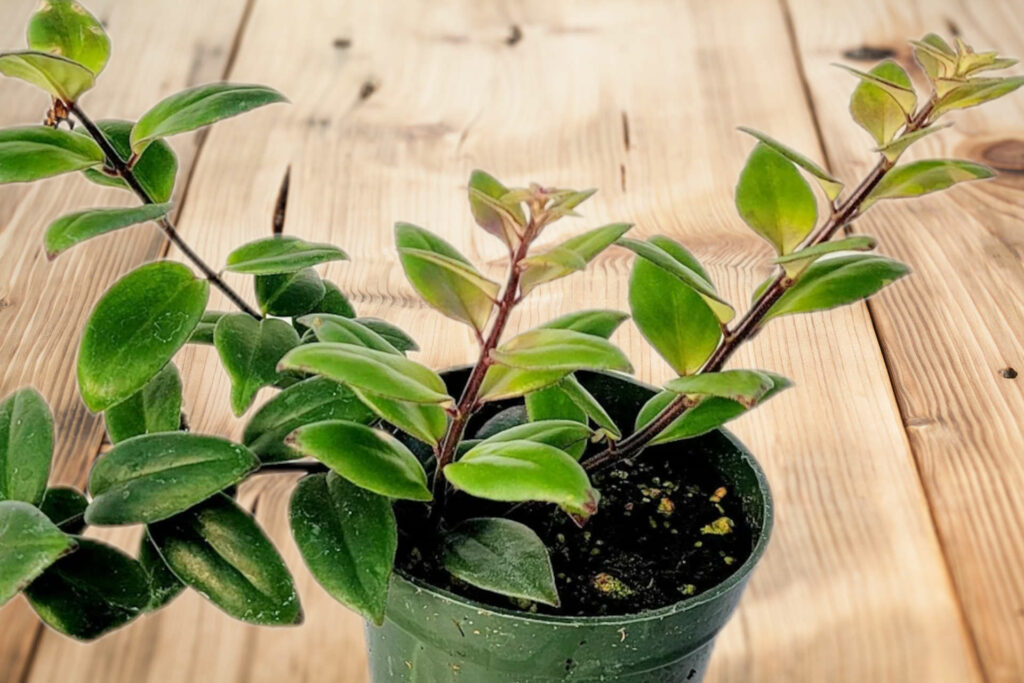
Keep Your Lipstick Plants in Healthy Soil
One of the most important preventative measures is to build healthy soil for your Lipstick plants. Healthy soil can provide a home to friendly insects, such as ladybugs and lacewings, that can help control harmful pests, such as aphids and spider mites.
Healthy soil can also help prevent many plant diseases, such as root rot and fungal infections, by improving drainage and aeration. To build healthy soil, you can add organic matter, such as compost or worm castings, to your potting mix. You can also use natural fertilizers, such as fish emulsion or seaweed extract, to provide nutrients and minerals to your soil.
General Good Care and Maintenance
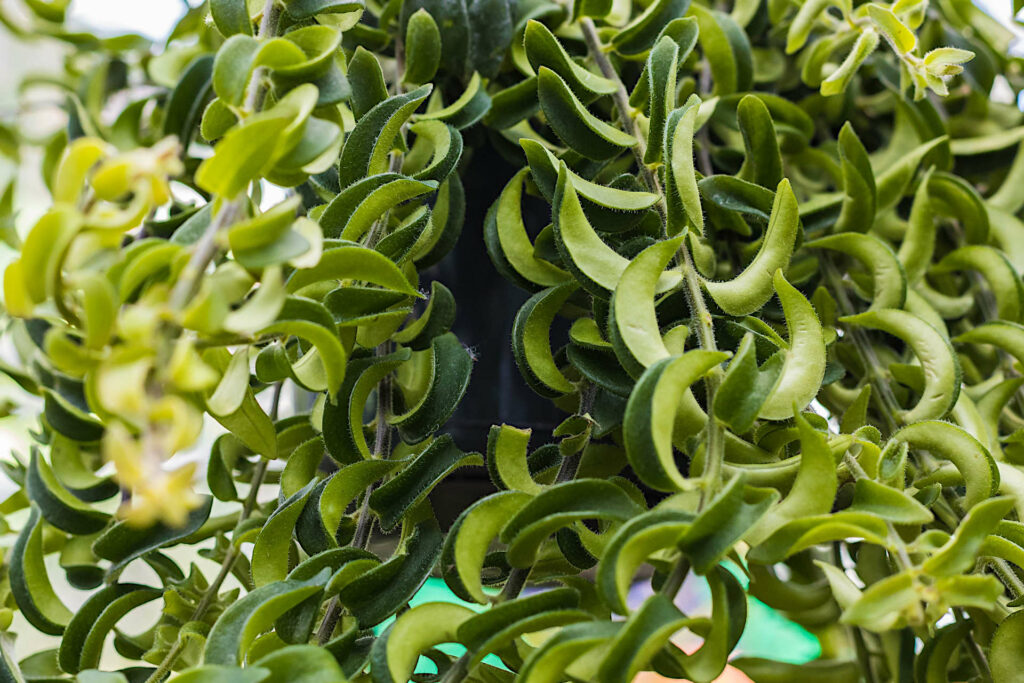
Proper lipstick plant care can go a long way to preventing disease or pest infestations.
Repotting
In spring, repot every three years with 'Houseplant' compost. Water the plant 24 hours beforehand to reduce the risk of damaging the root hairs.
Watering
Lipstick plants that are kept in overly wet, soggy soil are prone to fungal problems such as root rot. Root rot is the main disease that can affect your plants. Water your lipstick plant only when the top inch of soil is dry to the touch.
Light Requirements
The lipstick plant prefers bright, indirect sun and will bloom when given plenty of light. However, direct sunlight can scorch the leaves.
Humidity
Lipstick plants thrive in high-humidity environments. You can mist the leaves regularly, run a humidifier near it, or keep it on a pebble tray.
Cleaning Gardening Tools
It's important to always clean your gardening tools before and after using them to prevent the possibility of spreading disease or infection to other plants.
Space Your Lipstick Plants Correctly
A third preventative measure is to space your Lipstick plants correctly. Proper spacing can help prevent the spread of pests and diseases by allowing enough air circulation and light penetration among the plants. Spacing can also help reduce competition for water and nutrients among the plants. The ideal spacing for Lipstick plants depends on the size and shape of the plant and the container that you use. Generally, you should leave at least 6 inches of space between each plant. You can also prune or pinch back your Lipstick plants to maintain their shape and size.
Plant Your Lipstick Plants at The Right Time
A fourth preventative measure is to plant your Lipstick plants at the right time. Planting at the right time can help prevent pests and diseases by avoiding unfavorable weather conditions, such as extreme heat or cold, that can stress your plants and make them more susceptible to attacks.
The best time to plant your Lipstick plants depends on your climate and location. Generally, you should plant your Lipstick plants in spring or summer, when the temperatures are warm and stable. You should also avoid planting your Lipstick plants in rainy or humid seasons, as these can increase the risk of fungal diseases.
Final Thoughts: Common Pests and Diseases Affecting Lipstick Plants
Although lipstick plants are stunning additions to any home, but they are not immune to pests and diseases. Aphids, mealybugs, spider mites, and scale insects can all cause damage to these plants if left unchecked. Additionally, fungal diseases such as leaf spot, powdery mildew, root rot, and botrytis blight can affect their overall health and appearance and can hinder the lipstick plant from blooming.
If you implement preventative measures such as regular inspections, maintaining plant health, and using appropriate treatments like natural predators or insecticides, these issues can be effectively managed. By taking proper care of your lipstick plants, you can ensure their vibrant beauty and enjoy their presence for years to come.
FAQ
What are some common pests that can affect lipstick plants?
Some common pests that can affect lipstick plants are aphids, mealybugs, spider mites, and scale insects.
What are some signs of aphid infestation on lipstick plants?
Aphid infestation on lipstick plants can be indicated by curled, wilted, or yellow leaves. The plant's vigor and flowering may be reduced as well.
Are there any natural predators that can help control aphids on lipstick plants?
Yes, introducing ladybugs or lacewings to your garden can help control the aphid population on lipstick plants.
What are some other common pests that can affect lipstick plants?
In addition to aphids, other common pests that can affect lipstick plants include thrips, whiteflies, and spider mites.
How can I prevent and treat thrips infestation on my lipstick plant?
To prevent thrips infestation, regularly inspect your lipstick plant and remove any infested parts. You can use sticky traps or insecticidal soap to control thrips. Introducing natural predators like minute pirate bugs or predatory mites can also be helpful.
What are some signs of whitefly infestation on lipstick plants?
Signs of whitefly infestation on lipstick plants include tiny white insects flying around the plant when disturbed, as well as sticky honeydew residue on the leaves.
How can I prevent and treat whitefly infestation on my lipstick plant?
To prevent whitefly infestation, keep your garden clean and free from weeds. You can use sticky traps, insecticidal soap, or neem oil to control whiteflies. Introducing natural predators like parasitic wasps or ladybugs can also be effective.
Can lipstick plants attract other types of pests besides insects?
Yes, besides insects, lipstick plants can also attract snails or slugs. These pests can cause damage by eating the leaves or flowers of the plant.
How can I prevent and treat snail or slug infestation on my lipstick plant?
To prevent snail or slug infestation, create barriers around your lipstick plant using copper tape or diatomaceous earth. Handpicking the pests or using organic slug and snail baits can also help control the infestation.
Are there any diseases specific to lipstick plants that were not mentioned in the article?
One disease that can affect lipstick plants is bacterial leaf spot. It causes dark, water-soaked lesions on the leaves, which can eventually lead to leaf drop.
How can I prevent and treat bacterial leaf spot on my lipstick plant?
To prevent bacterial leaf spot, avoid overhead watering and provide good air circulation. Remove and dispose of infected leaves promptly. Copper-based fungicides can be used to treat the disease.
Can environmental factors like temperature or humidity affect the occurrence of pests and diseases on lipstick plants?
Yes, high humidity and warm temperatures can create favorable conditions for pests and diseases to thrive on lipstick plants. Proper ventilation and maintaining ideal temperature and humidity levels can help prevent infestations.
Are there any natural remedies I can use to prevent and treat pests and diseases on my lipstick plant?
Yes, there are several natural remedies you can try. For example, using a mixture of water and mild dish soap can help control certain pests. Neem oil is another natural insecticide that can be effective against various pests. Additionally, maintaining proper cultural practices like good watering techniques and providing adequate sunlight can contribute to the overall health and resilience of the plant.
Can over-fertilization or improper fertilization practices make lipstick plants more susceptible to pests or diseases?
Yes, over-fertilization or improper fertilization practices can lead to weak and stressed plants, making them more vulnerable to pests and diseases. It's important to follow the recommended fertilization guidelines for lipstick plants.
How can I ensure the long-term health of my lipstick plant and minimize the risk of pests and diseases?
To ensure the long-term health of your lipstick plant, provide it with the right amount of sunlight, water, and proper care. Regularly inspect the plant for any signs of pests or diseases, and take prompt action to prevent and treat any issues that arise. Maintaining a clean and well-maintained growing environment can also contribute to the plant's overall health and resilience.
Videos
Resources
- Microbiology Research Journal International: A Promising Sustainable Pest Management Technology: Microbial Bio-Control Agent
Kim is passionate about helping people create beautiful, healthy indoor spaces that are filled with plants. Kim believes that plants make us happier, healthier human beings, and she loves sharing her knowledge with others so they can experience the joys of plant care for themselves. <a href="https://plantcaresimplified.com/kim-marson/">Read more</a>
More Posts